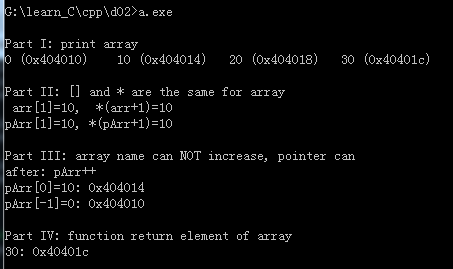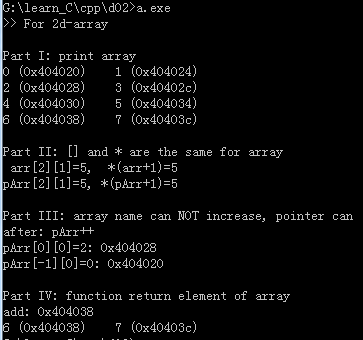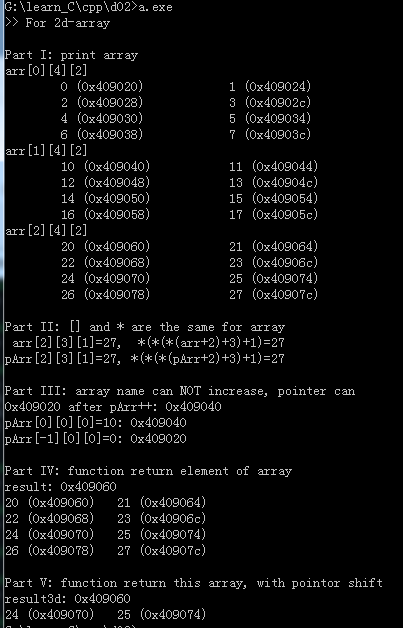-
C++ | 高维数组、指针、返回指向数组的指针的函数
对于1维数组,指针和数组的对应关系很好搞明白。
对于2维的,也凑合。
对于更高纬度的,就开始乱套了,特别是返回该高维数组指针的函数的声明。不过从3d往后又是同样的规律了。这一次,花时间捋顺它:
- 数组
- 指针
- 返回指向数组的指针的函数的声明和定义。
//数组指针:指向数组的指针 int (*p)[2]; // 按结合性,(*p)表示一个指针,指向的是[2]表示2元素,元素是int //指针数组:指针构成的数组 int *p[2]; //按结合性,p[2] 表示一个2元素数组,元素内容是指针,指向int- 1
- 2
- 3
- 4
- 5
1d 数组
/* * 摘 要:返回 1d数组、指针、返回指向数组指针的函数 */ #includeusing namespace std; int arr[4]= {0, 10, 20, 30}; //声明返回 数组元素的 函数 int *getInt(int index); //声明 参数是概述组的函数 void print(int *, int); int main(){ //定义指针,和数组平级 int *pArr = arr; //目测,看着消失掉一个维度信息 //1. 输出数组元素和指针 cout << "\nPart I: print array" << endl; print(arr, sizeof(arr)/sizeof(int) ); //2. 对数组, [] 与 * 具有相同的作用,获取内层,获取值。 cout << "\nPart II: [] and * are the same for array" << endl; cout << " arr[1]=" << arr[1] << ", *(arr+1)=" << *(arr+1) << endl; cout << "pArr[1]=" << pArr[1] << ", *(pArr+1)=" << *(pArr+1) << endl; //3. 数组名不能自增,但是指向它的数组可以 cout << "\nPart III: array name can NOT increase, pointer can" << endl; //arr++; //error: lvalue required as increment operand pArr++; cout << "after: pArr++" << endl; cout << "pArr[0]=" << pArr[0] << ": "<< &pArr[0] << endl; cout << "pArr[-1]=" << pArr[-1] << ": "<< &pArr[-1] << endl; //下标还可以是负数,只要地址有效 //4. 返回元素的函数 cout << "\nPart IV: function return element of array" << endl; int *result = getInt(3); cout << *result << ": " << result << endl; return 0; } // 函数定义 // 根据下标,返回子元素 int *getInt(int index){ return &arr[index]; } // 打印数组 void print(int *p2Int, int len){ for(int i=0; i<4; i++){ cout << p2Int[i] << " (" << &p2Int[i] << ")\t"; } cout << endl; } - 1
- 2
- 3
- 4
- 5
- 6
- 7
- 8
- 9
- 10
- 11
- 12
- 13
- 14
- 15
- 16
- 17
- 18
- 19
- 20
- 21
- 22
- 23
- 24
- 25
- 26
- 27
- 28
- 29
- 30
- 31
- 32
- 33
- 34
- 35
- 36
- 37
- 38
- 39
- 40
- 41
- 42
- 43
- 44
- 45
- 46
- 47
- 48
- 49
- 50
- 51
- 52
- 53
- 54
- 55
- 56
- 57
$ g++ -std=c++11 a8_1d.cpp
输出结果:

2d array
/* * 摘 要:2d数组、指针、返回指向数组指针的函数 */ #includeusing namespace std; int arr[4][2]= { {0,1}, {2,3}, {4,5}, {6,7} }; //声明返回 数组元素(1d数组) 的函数 int *getElement(int index); //声明 参数是该数组的函数:数组不能作为参数,但是指向它的指针可以 void print(int (*p)[2], int); int main(){ cout << ">> For 2d-array" << endl; //定义指针,和数组平级 int (*pArr)[2] = arr; //目测,看着消失掉一个(最高)维度信息 //定义指向多维数组的指针,一定要先把指针加圆括号 (*p),然后剩下的是该数组包含的内元素 //1. 输出数组元素和指针 cout << "\nPart I: print array" << endl; int length= sizeof(arr)/sizeof(int[2]); print( arr, length); //2. 对数组, [] 与 * 具有相同的作用,获取内层,获取值。 cout << "\nPart II: [] and * are the same for array" << endl; cout << " arr[2][1]=" << arr[2][1] << ", *(arr+1)=" << *(*(arr+2)+1) << endl; cout << "pArr[2][1]=" << pArr[2][1] << ", *(pArr+1)=" << *(*(pArr+2)+1) << endl; //3. 数组名不能自增,但是指向它的数组可以 cout << "\nPart III: array name can NOT increase, pointer can" << endl; //arr++; //error: lvalue required as increment operand pArr++; cout << "after: pArr++" << endl; //走过的是其子元素 cout << "pArr[0][0]=" << pArr[0][0] << ": "<< &pArr[0][0] << endl; cout << "pArr[-1][0]=" << pArr[-1][0] << ": "<< &pArr[-1][0] << endl; //下标还可以是负数,只要地址有效 //4. 返回元素的函数 cout << "\nPart IV: function return element of array" << endl; int *result = getElement(3); cout << "add: " << result << endl; for(int i=0; i<2; i++){ cout << result[i] << " (" << &result[i] << ")\t"; } return 0; } // 函数定义 // 打印数组 void print(int (*p2)[2], int len){ for(int i=0; i - 1
- 2
- 3
- 4
- 5
- 6
- 7
- 8
- 9
- 10
- 11
- 12
- 13
- 14
- 15
- 16
- 17
- 18
- 19
- 20
- 21
- 22
- 23
- 24
- 25
- 26
- 27
- 28
- 29
- 30
- 31
- 32
- 33
- 34
- 35
- 36
- 37
- 38
- 39
- 40
- 41
- 42
- 43
- 44
- 45
- 46
- 47
- 48
- 49
- 50
- 51
- 52
- 53
- 54
- 55
- 56
- 57
- 58
- 59
- 60
- 61
- 62
- 63
- 64
- 65
- 66
- 67
- 68
- 69
$ g++ -std=c++11 a8_2d.cpp
输出结果:

3d array
/* * 摘 要:3d数组、指针、返回指向数组指针的函数 */ #includeusing namespace std; int arr[3][4][2] = { { {0,1}, {2,3}, {4,5}, {6,7} }, { {10,11}, {12,13}, {14,15}, {16,17} }, { {20,21}, {22,23}, {24,25}, {26,27} } }; //声明返回 数组元素(2d数组) 的函数,开始变得面目可憎: int (*getElement(int index))[2]; // 返回指向原数组的指针,指针位置移动index位 int (*get3d(int index))[4][2]; //声明 参数是该数组的函数:数组不能作为参数,但是指向它的指针可以 void print(int (*p)[4][2], int); //数组名和最高维作为参数 int main(){ cout << ">> For 2d-array" << endl; //定义指针,和数组平级,大多数时候能替换 int (*pArr)[4][2] = arr; //目测,看着消失掉一个(最高)维度信息 //定义指向多维数组的指针,一定要先把指针加圆括号 (*p),然后剩下的是该数组包含的内元素 //1. 输出数组元素和指针 cout << "\nPart I: print array" << endl; int length= sizeof(arr)/sizeof(int[4][2]); print( arr, length); //2. 对数组, [] 与 * 具有相同的作用,获取内层,获取值。 cout << "\nPart II: [] and * are the same for array" << endl; cout << " arr[2][3][1]=" << arr[2][3][1] << ", *(*(*(arr+2)+3)+1)=" << *(*(*(arr+2)+3)+1) << endl; cout << "pArr[2][3][1]=" << pArr[2][3][1] << ", *(*(*(pArr+2)+3)+1)=" << *(*(*(pArr+2)+3)+1) << endl; //3. 数组名不能自增,但是指向它的数组可以 cout << "\nPart III: array name can NOT increase, pointer can" << endl; //arr++; //error: lvalue required as increment operand cout << pArr << " "; pArr++; cout << "after pArr++: "; //走过的是其子元素 [4][2]: 8* 4/int=32 cout << pArr << endl; cout << "pArr[0][0][0]=" << pArr[0][0][0] << ": "<< &pArr[0][0][0] << endl; cout << "pArr[-1][0][0]=" << pArr[-1][0][0] << ": "<< &pArr[-1][0][0] << endl; //下标还可以是负数,只要地址有效 //4. 返回元素的函数 cout << "\nPart IV: function return element of array" << endl; int (*result)[2] = getElement(2); cout << "result: " << result << endl; for(int i=0; i<4; i++){ for(int j=0; j<2; j++) cout << result[i][j] << " (" << &result[i][j] << ")\t"; cout << endl; } //5. 返回指向原数组的指针,指针位置有index偏移 cout << "\nPart V: function return this array, with pointor shift" << endl; int (*result3d)[4][2] = get3d(2); cout << "result3d: " << result3d << endl; cout << result3d[0][2][0] << " (" << &result3d[0][2][0] << ")\t"; cout << result3d[0][2][1] << " (" << &result3d[0][2][1] << ")\t"; return 0; } // 函数定义 // 打印数组 void print(int (*p2)[4][2], int len){ for(int i=0; i - 1
- 2
- 3
- 4
- 5
- 6
- 7
- 8
- 9
- 10
- 11
- 12
- 13
- 14
- 15
- 16
- 17
- 18
- 19
- 20
- 21
- 22
- 23
- 24
- 25
- 26
- 27
- 28
- 29
- 30
- 31
- 32
- 33
- 34
- 35
- 36
- 37
- 38
- 39
- 40
- 41
- 42
- 43
- 44
- 45
- 46
- 47
- 48
- 49
- 50
- 51
- 52
- 53
- 54
- 55
- 56
- 57
- 58
- 59
- 60
- 61
- 62
- 63
- 64
- 65
- 66
- 67
- 68
- 69
- 70
- 71
- 72
- 73
- 74
- 75
- 76
- 77
- 78
- 79
- 80
- 81
- 82
- 83
- 84
- 85
- 86
- 87
- 88
- 89
- 90
- 91
- 92
- 93
- 94
- 95
- 96
- 97
- 98
$ g++ -std=c++11 a8_3d.cpp输出结果:

测试题
定义一个返回 指向2d 数组的指针 的函数,并定义变量接收返回值。使用该返回值打印该2d数组。
参考实现:
#includeusing namespace std; int arr3d[3][4][2] = { { {0,1}, {2,3}, {4,5}, {6,7} }, { {10,11}, {12,13}, {14,15}, {16,17} }, { {20,21}, {22,23}, {24,25}, {26,27} } }; int (*getElement(int index))[2]; // 1.声明函数 int main(){ int (*result)[2] = getElement(2); // 2.接收返回值 //3.打印结果 for(int i=0; i<4; i++){ for(int j=0; j<2; j++) cout << result[i][j] << " (" << &result[i][j] << ")\t"; cout << endl; } return 0; } // 函数定义 int ( *getElement(int index) )[2]{ return arr3d[index]; } - 1
- 2
- 3
- 4
- 5
- 6
- 7
- 8
- 9
- 10
- 11
- 12
- 13
- 14
- 15
- 16
- 17
- 18
- 19
- 20
- 21
- 22
- 23
- 24
- 25
- 26
- 27
- 28
- 29
- 30
- 31
- 32
- 33
- 34
- 35
预期效果,打印出3维数组的下标为
[2]的维度,是一个int [4][2]数组。
截图略。小结:
- 数组变指针,实际上就是指向其第一个子元素的。
- 声明指向数组的指针,要注意加圆括号:
int (*parr)[2]; - 指向高维数组的指针声明,要损失其最高维信息,其余保留
- 返回指向数组的指针的函数的声明,也要注意加圆括号:
int ( *getElement(int index) )[2];
微软ADFS成本评估
使用LIO-SAM进行点云赋色 与 激光雷达和相机的精细化标定(防止自己忘记的博客)----- 激光雷达和相机的精细化标定
python从入门到精通合集(二)面向对象,文件IO、线程、进程
2023年【上海市安全员C证】考试及上海市安全员C证找解析
都2022年了 你还不了解什么是性能测试?
(Note)Elsevier爱思唯尔期刊投稿流程
windows线程池
centos7服务器升级ssh版本&&修复ssh漏洞 CVE-2016-20012、 CVE-2021-41617
spring boot 中@Value读取中文配置时乱码
